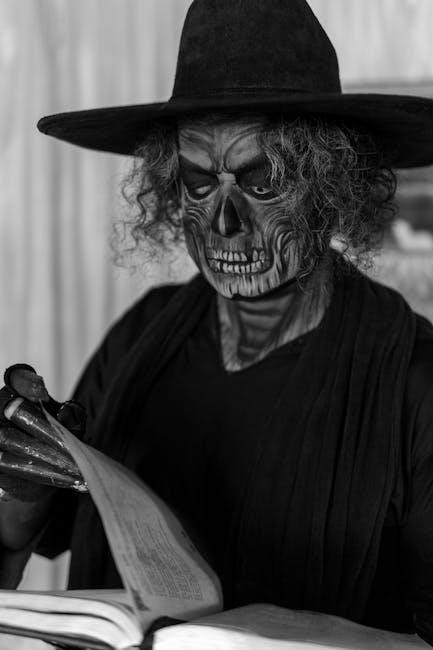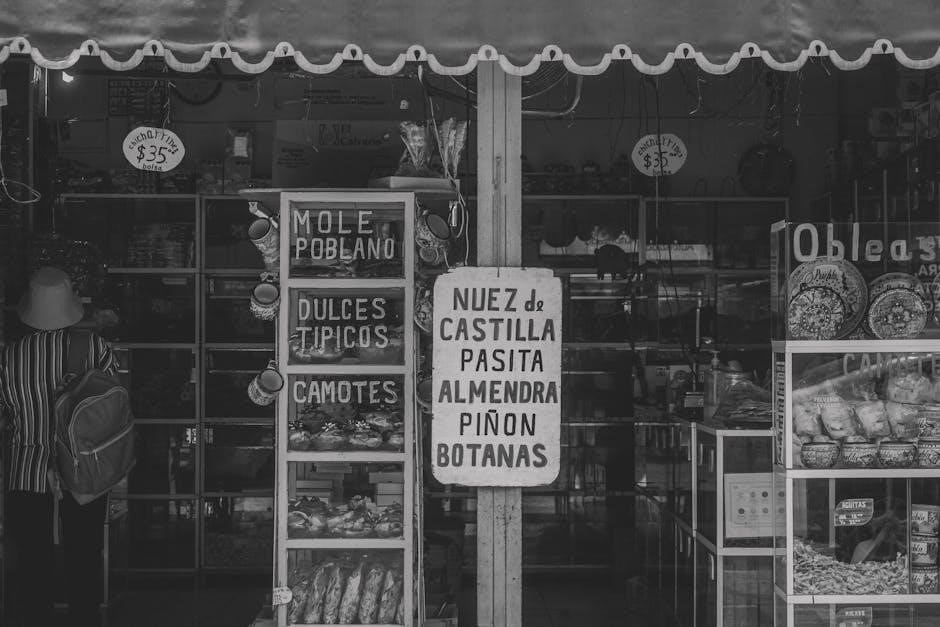Little Shop of Horrors is a musical comedy horror created by Howard Ashman and Alan Menken. It tells the story of Seymour, a florist who discovers a man-eating plant, Audrey II, in a dystopian Skid Row setting. Blending humor, horror, and iconic songs, it has become a cult classic, inspiring adaptations and captivating audiences worldwide since its 1982 Off-Broadway premiere.

The Plot Summary of “Little Shop of Horrors”
The story revolves around Seymour, a timid florist who discovers a mysterious plant, Audrey II, which he names after his crush, Audrey. As the plant grows, it demands human blood, leading to darkly comedic and tragic consequences.
Key Characters and Their Roles
Seymour Krelboyne is the protagonist, a nerdy and introverted florist who works at Mushnik’s Skid Row Florists. He discovers the mysterious plant Audrey II and becomes its caretaker, driven by his affection for Audrey.
Audrey Fulquard is Seymour’s coworker and the object of his affections. She is kind-hearted but trapped in an abusive relationship with Dr. Orin Scrivello.
Mr. Mushnik owns the flower shop and exploits Seymour’s talents while treating him poorly. He sees Audrey II as a way to save his failing business.
Audrey II is the man-eating plant that Seymour nurtures. It grows rapidly, demanding human blood and eventually flesh, becoming a central force in the story.
Dr. Orin Scrivello, D.D.S. is Audrey’s sadistic boyfriend, a dentist who enjoys causing pain. His death serves as a pivotal moment in the plot.
Crystal, Ronnette, and Chiffon are a trio of streetwise urchins who serve as narrators and a Greek chorus, providing commentary throughout the story.
The Setting: Skid Row and the Flower Shop
The story of Little Shop of Horrors unfolds in the gritty, urban landscape of Skid Row, a downtrodden neighborhood filled with decay and desperation. The primary setting is Mushnik’s Skid Row Florists, a struggling flower shop owned by the exploitative Mr. Mushnik. The shop is a symbol of neglect and decline, with wilted flowers, decaying corsages, and a rusted cash register; Skid Row itself is portrayed as a bleak, almost dystopian environment, where hope is scarce and life is a daily struggle. The arrival of Audrey II, the mysterious and carnivorous plant, contrasts sharply with the bleakness of the setting, bringing both excitement and terror to the community. The interplay between the grim surroundings and the bizarre events within the flower shop creates a unique blend of dark humor and horror, central to the story’s charm. The setting serves as a backdrop for the characters’ struggles and the plant’s sinister rise to power.

The Script and Its Musical Elements
The script of Little Shop of Horrors seamlessly blends dark humor and horror with iconic musical numbers. Composed by Alan Menken and written by Howard Ashman, it features rock, doo-wop, and R&B-inspired songs like “Skid Row (Downtown)” and “Feed Me (Git It).” These tracks drive the story, showcasing the bizarre yet captivating tale of Audrey II’s rise and Seymour’s dilemma, making the musical a timeless blend of comedy and horror.
Iconic Songs and Their Significance
The musical Little Shop of Horrors is renowned for its iconic songs, which blend humor, horror, and emotional depth. The opening number, “Skid Row (Downtown),” sets the tone, introducing the bleak urban setting and the characters’ struggles. “Suddenly, Seymour” highlights the blossoming romance between Seymour and Audrey, while “Feed Me (Git It)” captures the monstrous plant Audrey II’s menacing demands. These songs, composed by Alan Menken with lyrics by Howard Ashman, are central to the story’s progression. They not only advance the plot but also reveal character motivations and emotions. The doo-wop and Motown-inspired harmonies add a nostalgic yet eerie vibe, making the musical a unique blend of comedy and horror. The songs have become cult classics, resonating with audiences and embodying the show’s dark yet humorous tone. Their significance lies in their ability to balance lighthearted moments with the sinister undertones of Audrey II’s reign, making the musical unforgettable.
Dialogue and Character Development
The dialogue in Little Shop of Horrors is witty and sharp, driving the story’s dark humor and character growth. Seymour’s interactions with Audrey reveal his shy affection, while Mr. Mushnik’s harsh remarks highlight his exploitative nature. Audrey II’s menacing dialogue, though minimal, underscores the plant’s manipulative intelligence. The script’s exchanges are crucial in shaping each character’s arc, blending comedy with the horror elements. Seymour’s transformation from a timid clerk to a morally conflicted protagonist is particularly evident through his dialogue. Audrey’s conversations expose her tragic past and longing for escape, adding emotional depth. The script’s clever use of banter and monologues ensures that each character’s motivations are clear, making them relatable despite the absurdity of the story. The dialogue also serves to escalate tension, particularly as Audrey II’s influence grows, leading to the musical’s climactic and chaotic conclusion. This balance of humor and drama makes the characters memorable and the story engaging.
Historical Background and Adaptations
Little Shop of Horrors originated from Roger Corman’s 1960 low-budget film. Adapted into a musical by Howard Ashman and Alan Menken in 1982, it gained fame Off-Broadway. The 1986 film adaptation, directed by Frank Oz, featured a revised ending, contrasting the stage version’s darker conclusion, and became a cult classic.
From the 1960 Film to the Musical
The 1960 film The Little Shop of Horrors, directed by Roger Corman, was a low-budget horror-comedy that introduced the world to Seymour, Audrey, and the carnivorous plant. The story revolved around a small flower shop in a bleak urban setting, blending dark humor with absurdity. This cult classic laid the groundwork for Howard Ashman and Alan Menken’s 1982 musical adaptation, which expanded the narrative and infused it with catchy, memorable songs. The musical retained the core characters and premise but added depth through its score, making the plant Audrey II a central, menacing figure. The transition from film to stage emphasized the quirky charm and moral ambiguity of the story, transforming it into a beloved theatrical experience. This adaptation not only reimagined the original but also elevated it, creating a unique blend of horror and comedy that captivated audiences and solidified its place in theater history.
The 1986 Film Adaptation and Its Impact
The 1986 film adaptation of Little Shop of Horrors, directed by Frank Oz, brought the musical to the big screen with a star-studded cast, including Rick Moranis as Seymour and Steve Martin as the sadistic dentist Orin Scrivello. The film faithfully adapted the stage musical, retaining its iconic songs and dark humor. One notable aspect was the inclusion of two endings: the theatrical version featured a happier conclusion, while the director’s cut included the original, darker ending from the musical. The film received widespread critical acclaim, praised for its visuals, performances, and faithful adaptation of the source material. It became a cult classic, further cementing the legacy of Little Shop of Horrors. The success of the film also highlighted the versatility of the story, proving it could thrive both on stage and screen. This adaptation remains a benchmark for musical-to-film transitions, showcasing the enduring appeal of its unique blend of horror and comedy.
Downloading the Script in PDF Format
The Little Shop of Horrors script is widely available in PDF format. Official versions can be downloaded from trusted sources like Scripts.com or Google Drive. Free and paid options differ in quality and completeness.
Where to Find the Official PDF
The official Little Shop of Horrors script in PDF format can be downloaded from trusted sources like Scripts.com or Google Drive. These platforms offer the complete libretto, including the book, lyrics, and musical notes. The official PDF ensures high-quality content, accurately reflecting Howard Ashman and Alan Menken’s original work. Scripts.com provides a direct link to the document, while Google Drive may require a search for the file. Ensure you verify the source to avoid unauthorized versions. The official script includes the prologue, dialogue, and iconic song lyrics, making it essential for actors, directors, and fans alike. Uploaded in 2014, the PDF is titled Little-Shop-of-Horrors-1986-Movie-Script.pdf, offering a reliable resource for studying or producing the musical. Always check for the official watermark or publisher information to confirm authenticity.
Free vs. Paid Versions: What’s the Difference?

When searching for the Little Shop of Horrors script in PDF format, users often encounter both free and paid versions. Free versions are widely available on platforms like Scripts.com and Google Drive, offering access to the complete libretto, including dialogue and song lyrics. However, these may lack the polished formatting and additional content found in paid versions. Paid versions, available through official retailers like Amazon or the musical’s official website, provide higher quality, with no watermarks or restrictions. They often include exclusive features such as musical annotations, stage directions, and behind-the-scenes insights. While free versions are convenient for casual reading, paying supports the creators and ensures a professional-grade document. Choose the paid option for production purposes or if you want the definitive version of this cult classic. The official PDF is a worthwhile investment for enthusiasts and professionals alike.
Auditioning with “Little Shop of Horrors”
Auditioning for Little Shop of Horrors involves preparing for key roles like Seymour, Audrey, and Mushnik. Monologues and script excerpts are essential. Sides are often provided, so thorough preparation with the official PDF script is crucial.
Monologues for Key Characters

Monologues for Little Shop of Horrors are essential for auditions, offering insight into characters like Seymour, Audrey, and Mr. Mushnik. Seymour’s monologues highlight his nerdy charm and desperation, while Audrey’s reveal her vulnerability and longing; Mr. Mushnik’s dialogues showcase his comedic, authoritative nature. The plant Audrey II’s monologues are delivered through its menacing, rhythmic voice, adding dark humor. Supporting characters like Crystal, Chiffon, and Ronnette provide sassy, harmonious commentary. These monologues are available in the official PDF script, which includes the full libretto and lyrics. Audition materials often include specific scenes or monologues from the script, allowing actors to embody their characters fully. The Little Shop of Horrors script PDF is a vital resource for preparing auditions, ensuring accuracy and authenticity. Whether downloaded for free or purchased, the script provides the necessary tools to bring these iconic roles to life.
